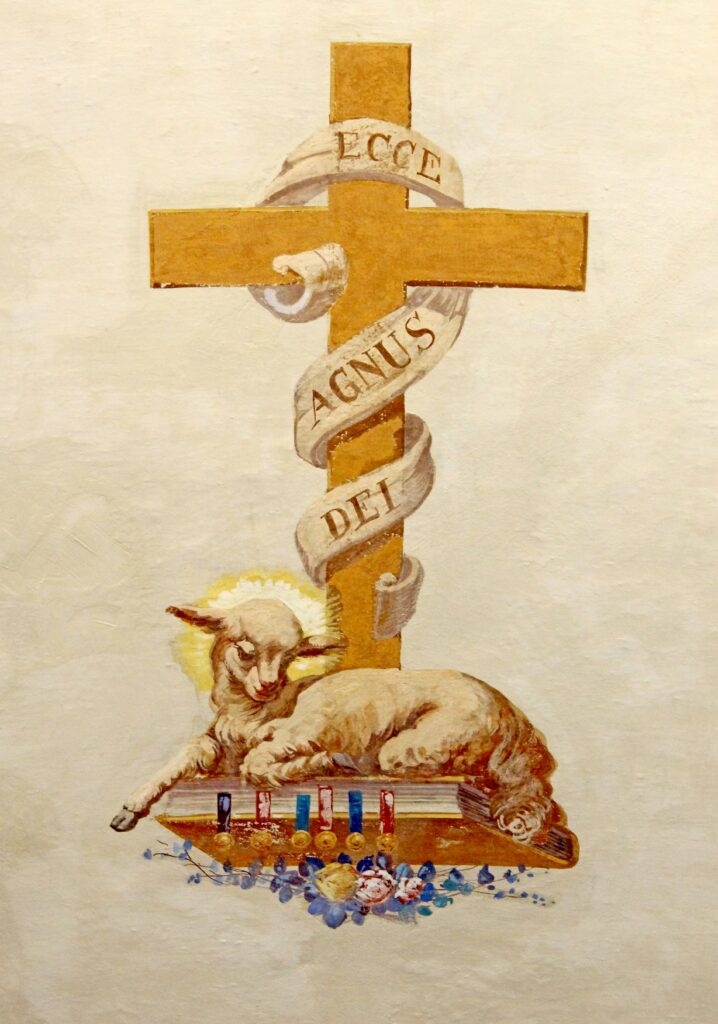⏱️ Estimated Reading Time: 24 min read
“Solus Christus” (“Christ alone”) is one of the Five Solas and pillars of Reformation theology, which asserts that salvation is obtained through Christ alone, and that no other mediator is necessary nor permissible. This teaching emphasizes Christ’s propitiatory atoning work on the cross as the singular means by which man attains peace with God and is saved from His wrath (Romans 5:8-9; 1 Thessalonians 1:9-10; 1 Thessalonians 5:9-19; John 3:36; Ephesians 2:3-5; Colossians 3:5-6).
The Reformers emphasized this doctrine in their challenge to the Roman Catholic Church’s teaching on the mediation of the Church, the saints, and the sacraments. However, Solus Christus is not unique to the Reformation. The centrality of Christ in salvation has been a consistent teaching throughout Church history. We will trace its roots beginning in the New Testament teaching of the Apostles, clearly seen in the early Church, continuing through the medieval period, recovered in the Reformation, and faithfully passed down to us to this day. This article will demonstrate that the concept of Christ as the sole mediator and the only means of salvation, has deep roots in the Christian tradition—from the teaching of the Apostles through the early Church fathers, medieval theologians, the Reformers and into our current times—and consequently is (and should remain) an indispensable core teaching of the Church for all time.
The Early Church and the Centrality of Christ in Salvation
One cannot look solely at Church history to understand what the Church has taught through the millennia without first looking at the Apostles’ teachings. The Apostles’ teachings are the foundation of the Church, with Christ being the cornerstone (Ephesians 2:20). Accordingly, it is imperative, while doing a historical systematic theological examination, to first begin with the Apostles’ teachings. The doctrine of Solus Christus has its foundation in the New Testament, where the uniqueness of Christ as the sole mediator of salvation is affirmed. One of the clearest biblical statements is found in Acts 4:12, where the Apostle Peter declares before the Sanhedrin, “There is salvation in no one else, for there is no other name under heaven given among men by which we must be saved.” Peter later affirms the centrality of Christ’s atoning work in his epistle. “He himself bore our sins in his body on the tree, that we might die to sin and live to righteousness. By his wounds you have been healed” (1 Peter 2:24).
Paul, the Apostle, reiterated Peter’s Christocentric message apart from initial contact with Peter or the other Apostles. Paul’s description of how he received his gospel message is clearly laid out in Galatians 1:11-24. He describes that it was directly God-given, not delivered to him by any man. He describes that he had no contact with the other Apostles and went immediately into Arabia and did not consult with anyone. After three years, he went to Jerusalem to visit Cephas (Peter). At that time, he had no other contact with the Apostles except James, the Lord’s brother.
Paul gives these facts as a defense to show that Christ Himself delivered to Paul his Christocentric message, which was the same gospel that Peter, James, and the other Apostles were preaching. This little detail helps us understand that Solus Christus is the foundation stone of the Apostles’ teachings, even to the Apostle Paul, who was “untimely born”. And what was Paul’s gospel? “For there is one God, and there is one mediator between God and men, the man Christ Jesus” (1 Timothy 2:5). He also talks of the preeminence and eternality of Christ and His peacemaking duties on the cross in Colossians 1. He further elucidates Christ and His wrath-bearing justification in Romans 5:8-9. These few portions of Paul’s writings display that his gospel, apart from the other Apostles’ influence, was the same Christocentric gospel as theirs.
The other Apostles also taught Solus Christus. John, the Beloved Apostle, taught this Christocentric gospel when he wrote in his epistle, “And this is the testimony, that God gave us eternal life, and this life is in his son. Whoever has the son has life; whoever does not have the son of God does not have life” (1 John 5:11-12). John only receives and preaches this gospel of Christ and His singular atoning work because he received it from Christ Himself. John records it in his gospel. In John 14:6, Christ claims His exclusivity in salvation, and John records a similar message in Revelation, that Christ is the firstborn from the dead, the ruler of the kings of the earth, and has freed us from our sins by His blood (Revelation1:5).
James, the brother of Christ, while not so explicitly preaching Solus Christus like Peter, Paul, and John, does it implicitly in his letter on Christian living. He says, “Therefore put away all filthiness and rampant wickedness and receive with meekness the implanted word, which is able to save your souls” (James 1:21). The implication here is that Christian doctrine (i.e., the word, which is Christ), as expressed in John 1:1-14, can save your souls. James further expounds on who Christ is in chapter 2, verse 1, when he calls Jesus Christ the “Lord of glory”.
Another Apostle, Jude, also echoes Solus Christus when he wrote his beautiful doxology. “Now to him who is able to keep you from stumbling and to present you blameless before the presence of his glory with great joy, to the only God, our Savior, through Jesus Christ our Lord, be glory, majesty, dominion, and authority, before all time and now and forever. Amen” (Jude 1:24-25). Here, Jude acknowledges Jesus Christ as the only means through which believers are presented blameless before God, and he attributes salvation to God through Christ alone. He also gives glory to Jesus Christ, saying that majesty, dominion, and authority before all time now and forever belong to Christ. This is a direct reference to the eternality of Jesus Christ. Thus, in Jude’s mind, Jesus is able be a successful intermediary because He is the eternal God. That is why he ascribes to Him salvation and eternal glory in the same doxology.
The Church Fathers inherited this Christocentric understanding of salvation from the Apostles and developed it further in the face of various theological and corporeal persecutions. Many paid the ultimate sacrifice for their Solus Christus teaching. Ignatius of Antioch (c. 35–107 A.D.), a bishop and martyr, emphasized the necessity of Christ in his letters to various Christian communities. In his letter to the Ephesians, he writes, “For our God, Jesus Christ, was conceived by Mary according to God’s dispensation, of the seed of David, and of the Holy Spirit; He was born and baptized that by His passion He might purify the water of baptism to the washing away of sin” (Epistle to the Ephesians, 18). Ignatius speaks directly to the sufficiency of Christ’s passion for the forgiveness of sins, reflecting the early Church’s clear understanding of Christ as the only way to be reconciled with God.
Another Church Father and martyr, Polycarp, bishop of Smyrna, is thought to be a direct disciple of the Beloved Apostle, John the Revelator. The theology of Solus Christus can be seen clearly in his life and teaching, but I would like to highlight his martyrdom in which his words of faithfulness to Christ show the dedication to that message.
Polycarp, an elderly man, who was reported to be 86 years old, was arrested by Roman authorities for refusing to renounce Christ. After his refusal to renounce Christ, he was brought into the arena and sentenced to be burned at the stake. After the flames did not consume his body and being unharmed by the flames, the executioners ultimately stabbed him with a dagger to complete the execution. Before he was executed, Polycarp was commanded to renounce Christ. Polycarp’s famous declaration of fealty to Christ shows how dedicated he was to Him and the saving power of his cross. He said, “Eighty and six years have I served him, and he has done me no wrong. How then can I blaspheme my king and my savior?” (Polycarp’s Epistle to the Philippians and the Martyrdom of Polycarp: Introduction, Text, and Commentary, 253).
Another Church Father, Justin Martyr (c. 100–165 A.D.), also upheld the uniqueness of Christ in salvation, particularly in his dialogue with the Jewish scholar Trypho. Justin contended that the Mosaic Law, though important in the history of salvation, was insufficient to save. He argues that the sacrifices of the Old Covenant pointed forward to Christ, the true and final Lamb of God. He writes, “The blood of the lambs offered in sacrifice could not take away sins, but this was a type of the true Lamb, Jesus Christ, who was offered as a sacrifice once for all” (Dialogue with Trypho, 40). Justin’s Christ-centered understanding of atonement underscores that from the earliest period, the Church viewed Christ as the fulfillment of salvation history, not merely a part of it.
The most prominent defender of the centrality of Christ in the early Church was Athanasius of Alexandria (c. 296–373 A.D.). In his classic work On the Incarnation, Athanasius fought against the Arian heresy, which denied the full divinity of Christ. Athanasius argued that only the full divinity of Christ could account for the salvation of humanity.
He writes, “He was made man that we might be made God; and He manifested Himself by a body that we might receive the idea of the unseen Father” (On the Incarnation, 54). For Athanasius, Christ’s incarnation and atoning work were not supplementary but essential for salvation. Only God Himself, in the person of Christ, could redeem humanity from sin and death. Athanasius paid a high price because of his defense of Christ and His divinity, for which he was exiled five times for 17 years. He became known as Athanasius Contra Mundum (Latin for “Athanasius Against the World”) because of his bold stance against Arianism at all costs. His ardent defense of Christ’s divinity and, thus—in principle—his defense of Solus Christus, makes him one of the key figures in the development of Solus Christus.
Athanasius was integral in the writing of the Nicene Creed. And although the Nicene Creed was written to address other issues, namely Trinitarianism and Christology (Christ’s divinity) contraposed to the Arians, it certainly communicates a Solus Christus perspective when it describes Christ, “Who because of us men and because of our salvation came down,” (The Creeds of Christendom, 215-216). This succinct phrase found in the creed describes the reason for Christ’s incarnation: “because of our salvation”. Here, we have more evidence of Athanasius’ fingerprints slowly forming Solus Christus through the early Church.
Augustine of Hippo (354–430 A.D.), one of the most influential theologians in the early Church, also emphasized the centrality of Christ in salvation. In his work The City of God, Augustine affirms that “there is no other mediator between God and men than the man Christ Jesus” (Book 9, chapter 15). He argues that no human works, merit, or ecclesiastical interventions can substitute for Christ’s saving work. St. Augustine consistently taught Solus Christus—that salvation comes through Christ alone—in his theological writings, sermons, and pastoral letters. Whether in works like The City of God, On Nature and Grace, or Enchiridion, Augustine emphasized that Christ is the only mediator between God and humanity, and that salvation cannot be achieved through human effort or any other intermediary. His defense against heresies such as Pelagianism further solidified his teaching that only through Christ’s grace can humanity be saved. In Augustine’s theology, the grace of God—mediated through Christ alone—was the decisive factor in salvation, building the foundation for many of the Reformers, who would all call on Augustine and his work for guidance.
The Medieval Period and Christ’s Role in Salvation
In the medieval period, the development of the sacramental system and the growing authority of the Papacy seemed to obscure the clarity of Solus Christus. However, many prominent medieval theologians continued to emphasize the necessity of Christ’s unique role in salvation. Although we saw Solus Christus in the Medieval period “through a glass dimly” (1 Corinthians 13:12), it was still visible.
Just as God saved a remnant of 7,000 in Elijah’s day who had not bowed the knee to Baal, God also saved a remnant of theologians who were still preaching the exclusivity of Christ in salvation during the Medieval period. One of those who saw Solus Christus “through a glass dimly” was Anselm of Canterbury (1033–1109 A.D.). He articulated one of the most important medieval defenses of Christ’s atonement in his work Cur Deus Homo (“Why God Became Man”).
Anselm developed what has come to be known as the “satisfaction theory of atonement”, which holds that only a being who is both fully God and fully man could satisfy the debt humanity owes to God for sin. Anselm writes, “No one but God can make this satisfaction, and no one but man ought to make it; hence it is necessary for a God-Man to make it” (Cur Deus Homo, II, 6). Anselm’s argument makes it clear that Christ’s work on the cross is not only necessary, but sufficient for the salvation of humanity. Anselm’s arguments were a few more of the building blocks laid for future generations like John Calvin.
Thomas Aquinas (1225–1274 A.D.), perhaps the most significant theologian of the Middle Ages, also upheld the centrality of Christ’s atoning work in his magnum opus, the Summa Theologica. Aquinas explains that Christ’s death was the perfect sacrifice, satisfying divine justice and providing the basis for humanity’s reconciliation with God.
He writes, “Christ’s Passion is the cause of the remission of sins, through which man is reconciled to God” (Summa Theologica, III, Q.48, A.1). Although Aquinas also emphasized the importance of the sacraments, he viewed them as the means by which the grace of Christ’s sacrifice is applied to believers, not as additional works that contribute to salvation. Christ’s work on the cross remained the foundation of his soteriology.
Throughout the medieval period, other theologians and mystics also pointed to the sufficiency of Christ in salvation. Bernard of Clairvaux (1090–1153 A.D.), a Cistercian monk and mystic, emphasized the love of Christ and the centrality of His death for the believer’s union with God. In his sermons on the Song of Songs, Bernard stresses the importance of Christ’s redemptive work, saying, “The death of Christ is sufficient for all, but it is applied only to those who believe” (Sermons on the Song of Songs, Sermon 61). His understanding of salvation echoes the later Reformation principle of Solus Christus. Although Solus Christus in the Medieval period became more and more cloudy through the falsification of Christ’s mediatory work alone, it was seen “through a glass dimly” by many, which the pre-reformers like Jan Huss carried on with boldness.
The Building Blocks of Solus Christus in Pre-Reformation Thought
Jan Huss (1372–1415 A.D.), a precursor to the Reformation, also taught the doctrine of Solus Christus, emphasizing Christ as the sole mediator between God and humanity. Drawing from the works of John Wycliffe, Huss rejected the ecclesiastical abuses of his time, particularly the authority of the Pope and the Church hierarchy, advocating instead that salvation could be found only through Christ.
In his treatise De Ecclesia (“On the Church”), Huss declared that “Christ is the only head of the Church” and that no human intermediary, including the pope, could claim such authority over the Church or believers’ salvation (Huss, De Ecclesia, Chapter 6). Huss further argued that the merit of Christ’s sacrifice was fully sufficient for the forgiveness of sins, without the need for indulgences or the intervention of the clergy. His Christocentric theology, which prefigured the Reformation’s emphasis on Solus Christus, ultimately led to his condemnation as a heretic by the Council of Constance and his martyrdom in 1415 A.D.
Before the event of Huss’s martyrdom at the stake, he turned to his executioners and said, “Today you burn a goose (Huss), but in one hundred years a swan will arise which you will prove unable to boil or roast.” Later, Martin Luther understood Huss’ word and embraced the idea that he was the swan that God had raised him up to continue his work in Solus Christus. Scholars have recognized Huss’ theological alignment with Reformation principles, noting his role in preparing the way for the later Reformers, particularly in his focus on the sufficiency of Christ’s atoning work (Fudge, 2010).
The Reformation and the Reassertion of Solus Christus
By the time of the Protestant Reformation in the 16th century, the emphasis on the Church’s role in salvation, including the intercession of saints, indulgences, and the sacramental system, had become more pronounced. The Reformers responded by returning to the early Church’s emphasis on the sufficiency of Christ’s work for salvation. Martin Luther (1483–1546 A.D.) was the leading voice in reasserting Solus Christus during the Reformation. Luther’s theology of justification by faith alone (Sola Fide) was based on his understanding of Christ’s exclusive role in salvation. In his Heidelberg Disputation (1518 A.D.), Luther famously declared, “The cross alone is our theology,” emphasizing that it is the work of Christ, not the Church, that saves. He rejected the idea that the Church or its sacraments could add anything to Christ’s finished work on the cross. Luther’s return to the primacy of Christ is perhaps most clearly seen in his rejection of the practice of indulgences, where he argued that only Christ’s merit, not the merits of the saints or the Church, could atone for sin.
John Calvin (1509–1564 A.D.), another key Reformer, also championed the doctrine of Solus Christus. In his Institutes of the Christian Religion, Calvin emphasized that Christ alone is the mediator between God and man. He writes, “We see that our whole salvation and all its parts are comprehended in Christ. We should therefore take care not to derive the least portion of it from anywhere else” (Institutes, II.16.19). For Calvin, any attempt to find salvation in the works of the law, human merit, or ecclesiastical authorities was a direct affront to Christ’s sufficiency.
The doctrine of Solus Christus was enshrined in the major confessions of the Reformation, including the Augsburg Confession (1530 A.D.) and The Westminster Confession of Faith (1647 A.D.). The Westminster Confession states, “The Lord Jesus, by His perfect obedience and sacrifice of Himself, which He through the eternal Spirit once offered up unto God, has fully satisfied the justice of His Father; and purchased not only reconciliation but an everlasting inheritance in the kingdom of heaven, for all those whom the Father has given unto Him” (Chapter 8, Article 5). This confession leaves no room for human merit or additional mediators in the process of salvation and encapsulates the Reformers’ conviction that Christ alone is sufficient for salvation, a teaching that we have seen has been established in Christian theology from its earliest days.
The Persistence of Solus Christus in Post-Reformation Theology
The emphasis on Solus Christus did not fade after the Reformation. For instance, in the Puritan tradition, figures like John Owen (1616–1683 A.D.) echoed these themes. Owen’s treatise, The Death of Death in the Death of Christ, is an extended meditation on the completeness of Christ’s atonement. Owen argues that Christ’s death alone is sufficient for the salvation of His people and that it is efficacious for all for whom it was intended. He states, “Christ died for all the sins of all the elect, and paid their full ransom price, securing for them reconciliation with God” (The Death of Death, Book 3).
Owen’s theology, like that of the Reformers, reaffirms that Christ alone is the basis of salvation. Later on, Jonathan Edwards (1703-1758 A.D.) displayed throughout the breath of his teaching, a deeply Christocentric theology. For instance, his most famous sermon, Sinners in the Hands of an Angry God, demonstrated Solus Christus, wherein he said, “There is no other mediator but Christ who is sufficient to stand between a holy and just God and sinful man, to atone for sins and to purchase redemption.”
Not only is the emphasis on Christ alone seen throughout Church history and reestablished during the Reformation and on through post-reformation thought, but there is a resurgence even now in reformation thought and the sufficiency of Christ and Christ alone for salvation (Solus Christus). We are seeing this in the works of current Church leaders, such as John Piper, D.A. Carson, Sinclair Ferguson, Paul Washer, Ligon Duncan, Kevin DeYoung, and many other contemporaries. The concept of Solus Christus is not being lost on this generation, but rather it is being strengthened through this reformed resurgence.
Conclusion: Solus Christus and Christ’s Cross is the Whole Counsel of God
The doctrine of Solus Christus was not a novelty introduced by the Reformers, but a consistent teaching throughout Church history—from the early Church fathers, such as Ignatius, Justin Martyr, and Athanasius, to medieval theologians like Anselm. The emphasis with which all of Church leadership—starting with the Apostles, Church fathers, theologians, historians, and continuing with present-day pastors—has placed on the sufficiency and singularity of Christ’s atoning and intermediary work on the cross, illustrates and defends the importance that all Christians should likewise place on this singular work, which Christ has undertaken on our behalf.
There is a temptation in modern ministry and church life to place an emphasis on other things, apart from the sole propitiatory atoning work of Christ. Emphasizing any other work (i.e., our own good works or our own striving to please a holy God) is a fool’s errand. The emphasis that all of Church history places on Christ’s work alone instructs that we may not step out of line with this belief and teaching that is based on scripture.
We may not be so arrogant as to get out of step with all of Church history in the singularity of Christ’s propitiatory atoning work. We must take care in all of protestant and evangelical Christianity not to present other means by which man may be reconciled to God in our teaching. The temptation is to think we are smarter or wiser, or have evolved into a smarter and more robust theology. It is folly. If we believe or teach that man may be reconciled to God through other means or other mediators, we are teaching people how to enter into a Christless eternity; for as Paul taught us, “there is one mediator between God and men the man, Christ Jesus” (1 Timothy 2:5).
If we teach anything else, we err greatly and may in fact jeopardize the eternal destiny of those we teach. Dear Pastor, Elder, Lay Leader, or any other Church Leader, please teach and focus on the centrality of Christ, Him crucified, and coming again, and thus you will “save yourself and your hearers” (1 Timothy 4:16).
I would leave you with the most concise and challenging words on this topic from J.C. Ryle, who also wrote on the cross of Christ and its singularly powerful work. He said in his book, The Cross Crucified with Christ, and Christ Alive in Me, “Depend upon the cross of Christ, the death of Christ on the cross to make atonement for sinners—that is the central truth in the whole Bible” (The Cross Crucified with Christ, and Christ Alive in Me, Kindle Location 154). Ryle further elucidated that Christ and Him crucified must be the centerpiece of our evangelism and missions when he wrote:
“The cross is the secret of the missionary success. Nothing but this has ever moved the hearts of the heathen. As the cross has been lifted up, missions have prospered. This is the weapon that has won victories over hearts of every kind in every quarter of the globe: Greenlanders, Africans, South Sea Islanders, Hindus, and Chinese have all felt its power” (The Cross Crucified with Christ, and Christ Alive in Me, Kindle Location 321).
In conclusion, Scripture, Church fathers, and all of Church history confirms that the whole council of God is embodied in His son, Jesus Christ; and the forgiveness of sins that can be found only in Christ and Christ alone. Books and volumes could be written on this subject because it has been a consistent and constant theme of Church history that Christ, our Savior, and Lord, has given Himself in our place for our sins so that man may have peace with God through His sacrificial blood. The church bells of history have continually been ringing out with this message.
Jesus, Lord of all, has not counted “equality with God a thing to be grasped, but emptied himself, by taking the form of a servant, being born in the likeness of men. And being found in human form, he humbled himself by becoming obedient to the point of death, even death on a cross. Therefore, God has highly exalted him and bestowed on him the name that is above every name, so that at the name of Jesus every knee should bow, in heaven and on earth and under the earth, and every tongue confess that Jesus Christ is Lord, to the glory of God the Father” (Philippians 2:6-11). May this message of Christ’s sufficient mediatory work continue to ring out throughout all of history. May it ring out into eternity in Christ alone, our hope is found.
References:
- Ignatius of Antioch, Epistle to the Ephesians Found in: The Apostolic Fathers, edited and translated by Bart D. Ehrman, Loeb Classical Library, Harvard University Press, 2003.
- Polycarpe, and Paul Hartog. Polycarp’s Epistle to the Philippians and the Martyrdom of Polycarp: Introduction, Text, and Commentary. Oxford Apostolic Fathers. Oxford: Oxford Univ. Press. 2013.
- Justin Martyr, Dialogue with Trypho Found in: The Writings of Justin Martyr, translated by Thomas B. Falls, Christian Heritage, 1948.
- Athanasius of Alexandria, On the Incarnation Edition: On the Incarnation, translated and edited by John Behr, St Vladimir’s Seminary Press, 2011.
- Augustine of Hippo, The City of God Edition: The City of God, translated by Henry Bettenson, Penguin Classics, 2003.
- Anselm of Canterbury, Cur Deus Homo Edition: Anselm of Canterbury: The Major Works, edited by Brian Davies and G. R. Evans, Oxford University Press, 2008.
- Thomas Aquinas, Summa Theologica Edition: Summa Theologica, translated by the Fathers of the English Dominican Province, Christian Classics, 1981.
- Bernard of Clairvaux, Sermons on the Song of Songs Edition: On the Song of Songs, translated by Kilian Walsh, Cistercian Publications, 1980.
- Huss, John. De Ecclesia. Translated by David S. Schaff. Charles Scribner’s Sons, 1915.
- Fudge, Thomas A. Jan Hus: Religious Reform and Social Revolution in Bohemia. I.B. Tauris, 2010.
- Martin Luther, Heidelberg Disputation Found in: Luther’s Works, Vol. 31: Career of the Reformer I, edited by Harold J. Grimm, Fortress Press, 1957.
- John Calvin, Institutes of the Christian Religion Edition: Institutes of the Christian Religion, edited by John T. McNeill, translated by Ford Lewis Battles, Westminster John Knox Press, 1960.
- The Westminster Confession of Faith Edition: The Westminster Confession of Faith, Free Presbyterian Publications, 2016.
- Edwards, Jonathan, 1703-1758. Sinners in the Hands of an Angry God. A Sermon, Preached at Enfield, July 8, 1741, at a Time of Great Awakenings; and Attended with Remarkable Impressions on Many of the Hearers. By the Late Reverend Mr. Jonathan Edwards, President of the College of New-Jersey. New-York :Printed by G. Forman, opposite the post-office, for C. Davis, no. 94, Water-Street, 1797.
- Philip Schaff, History of the Christian Church Edition: History of the Christian Church, 8 Volumes, Hendrickson Publishers, 2002.
- N.D. Kelly, Early Christian Doctrines Edition: Early Christian Doctrines, Harper & Row, 1978.
- Jaroslav Pelikan, The Christian Tradition: A History of the Development of Doctrine, Vol. 1: The Emergence of the Catholic Tradition (100-600) Edition: University of Chicago Press, 1971.
- Ryle, J.C. 2019. The Cross: Crucified with Christ, and Christ Alive in Me. Revised Edition. Abbotsford, WI: Aneko Press.

Solus Christus: The Only Way and the Only Hope
Richard P. Moore is an evangelist, youth pastor, and missionary in Germany since 2014. He is an experienced youth pastor and preacher. He’s been in church ministry for over 20 years. He has his Bachelors in Youth Ministry and Theology and Masters of Leadership, Evangelism, and Discipleship from Columbia International University. He is currently pursuing a PhD at Bakke Graduate University. He is author of “Divergent Theology: An Inquiry Into the Theological Characteristics of the Word of Faith Third Wave Movement and The New Apostolic Reformation,” which has been translated into German called, “Entwurzelt: Aktuelle christliche Irrtümer.” Richard’s podcast is called “CHURCHepreneurs.”
He is married to Simone with three children together, Ana, Lydia, and Caleb. He is a youth communicator, church planting speaker, and theologian. His vision is to see youth come to know, worship, and obey Jesus authentically. Check out Richard’s ministry at his website www.richardpmoore.net




